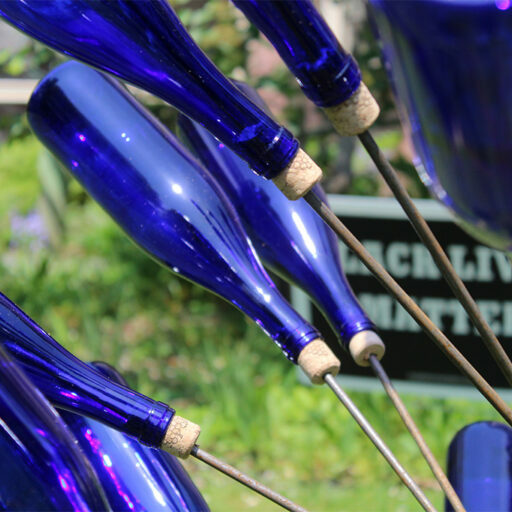
Cambridge’s Caribbean connection runs deep
By Marni Zea Clippinger, 2022

“Forgotten Souls of Tory Row: Remembering the Enslaved People of Brattle Street,” the installation of bottle trees now on view at the History Cambridge headquarters (159 Brattle St.), was inspired by a custom that originated in Congo in West Africa long ago. The tradition of bottle trees was brought to the Caribbean and the Southern United States by enslaved people and passed down through generations. While bottle trees signify different things to different people, there is agreement that the bottles are placed on tree branches to destroy evil spirits and to capture the energy, spirit and memories of ancestors.
The striking grove of blue bottle trees installed by Black Coral represents the people – adults and children – who were enslaved by the 18th century owners of the mansions on Brattle Street (many of whom amassed fortunes through their plantations in the Caribbean). The sculpture aims to honor the memory and the humanity of the enslaved individuals who lived and worked on Brattle Street. For a deeper understanding of the connections between Brattle Street and the slave trade, see “The Sugar Planters of Brattle Street,” a talk by Caitlin Galante D’Angelis Hopkins, former research associate at the Harvard and Slavery project.
Since history is written by those with money and power, we know very little about the enslaved individuals who lived in Cambridge, but we know they were here. We know this from their gravestones and from the letters, records, wills and legal documents associated with the people who owned them. As an example, the archives of History Cambridge contain notes taken by Nicholas Hoppin, rector of Christ Church in Cambridge from 1839 to 1874, about an undated conversation he had with Darby Vassall, son of Anthony Vassall, an enslaved person. Darby told Hoppin that he was born in the house of John Vassall (now the Longfellow House) in 1869. His father, Anthony, was coachman to Henry Vassall, one of the Brattle Street denizens deeply involved in the slave trade who owned vast sugar plantations in Jamaica and Antigua. According to Darby, his father was “inveigled from Spain under pretense of seeing the country,” and when he reached Jamaica, he was “sold to Henry Vassal [sic] who brought him to Cambridge.”
Like many enslaved persons who lived here, Anthony Vassall came to Cambridge – against his will – by way of the Caribbean. While the historic reasons for the Cambridge-Caribbean connection are deeply rooted in the tragedy of slavery, today Cambridge and its surroundings have a thriving community of individuals of Afro-Caribbean descent.

A few years ago, Cambridge History’s Caribbean Heritage Oral History Project conducted interviews with nine Cambridge residents who were either born in or have roots in the Caribbean. Their areas of ancestry included Barbados, Haiti, Jamaica, Puerto, Rico, Suriname and Trinidad. You can read about the people interviewed and listen to their stories on the History Cambridge website. These interviews help us understand what it’s like to be from Cambridge and from the Caribbean. (Be sure to also check out our self-guided tour Caribbean Community in the Port.)
June is National Caribbean Heritage Month, and History Cambridge would like to invite you to tell us your stories: What is your connection to the Caribbean? Were you moved by the bottle tree installation and the history it represents? You can fill out this short survey or email us at info@cambridgehistory.org and arrange to give us a more detailed oral history of your own. Either way, we look forward to hearing from you and hearing your stories.
Celebrate Cambridge’s Caribbean heritage this summer! For a family-friendly Caribbean foodie festival, be sure to check out this year’s Boston JerkFest on July 2. And the Cambridge Carnival International, a colorful and festive celebration rooted in African tradition, will mark its 29th year of operation this fall on Sept. 11.
Marni Zea Clippinger is a board member at History Cambridge.
This article was originally published in our “Did You Know?” column in Cambridge Day.






